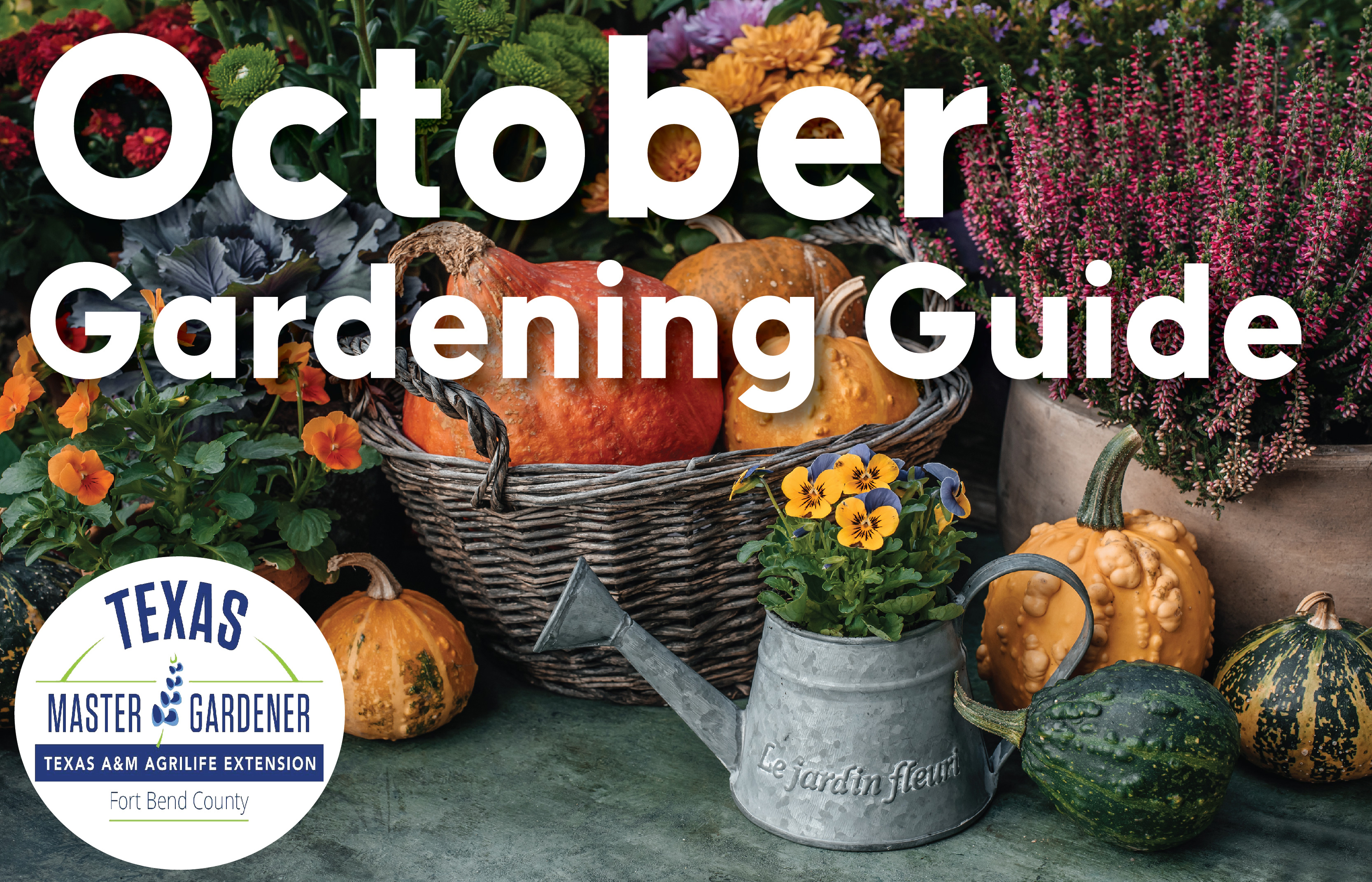
October Gardening Tips for Fort Bend County: Master Gardeners Share What to Plant and Prepare This Fall
This information has been generously provided to Fort Bend County residents free of charge by the Fort Bend County Master Gardeners, an expert group of trained volunteers assisting Texas A&M AgriLife Extension Service in educating the community using research-based horticultural information.
Did you know that the Fort Bend County Master Gardeners offer free training, events and other resources all year round? To learn more, visit fbmg.org.
Fall is for planting! October is a great month for planting trees and other perennial plants. Here are other things to consider for your gardening to-do list.
-
Although we don’t anticipate any freezes or frosts this month (or next), now is a good time to gather the supplies you will want on hand when they do occur. Read about how to protect your plants from frosts and freezes so you will know what supplies to have on hand.
-
It is not too late to put out a hummingbird feeder. Some hummers will still be in the area into November. Learn more about the ruby-throated hummingbird.
-
Plant wildflowers in the fall for flowers in the spring! Learn how to plant wildflowers, including bluebonnets, here.
-
Plant perennial culinary herbs such as rosemary and sage. The fresh herbs will add flavor to your recipes throughout the year. Many of these plants are ornamental enough to include in your flower gardens. Also, many can be grown in pots so they can be easily sheltered in case of cold weather. Learn more here.
-
Harvest your annual cold-sensitive herbs, such as sweet basil. It is best to harvest them in the morning when their flavor is at its best. Learn how to dry herbs so you can use them later.
-
Buy spring flowering bulbs now, such as tulips and daffodils, but it may be too warm to plant them. Store them in the refrigerator until it cools down and then plant them as described here for beautiful spring color.
-
If you have not already done so, divide your bulbs that seem crowded. You will then have twice (or more!) the bulbs for your garden or to share. Watch this video to learn about bulb division.
-
Plant roses! Roses may be most beautiful in the spring, but October is the best month to plant them so they can establish a strong root system before the cooler months. Learn about Earth-Kind® roses you may want to consider for your garden.
-
As the weather cools, you may want to give your hedges a final pruning for the year. Learn about the Earth-Kind® proper pruning techniques.
-
Adjust your automated irrigation system. Water only if there has not been at least 1/2 inch of rain in the previous 10 days. You can save water expense (and help the planet) by not overwatering. Did you know there is an online calculator that helps you know how much to water based on your area and recent rainfall? Learn about this calculator and how to use it.
-
As the weather cools, many turfgrasses are more vulnerable to large patch, a turf disease that appears as circular brown patches in your turf. Learn more about identifying and treating this problem.
-
Trim your tropical milkweed and keep it trimmed to 6 inches throughout the rest of the fall and winter months. Or better yet, plant only native milkweeds, which do not put Monarch butterflies at risk. If the Monarchs lay eggs this late in the year, it will be too cold for the larva to fully develop. Learn more about tropical milkweed versus native milkweed here.
-
If your turf is not thriving, you might need to apply some fertilizer later this month. Be careful you do not apply too much because too much nitrogen encourages certain diseases and pests. Learn how much and what kind of fertilizer to apply.
-
Mulch, mulch, mulch (always a good suggestion)! The mulch will protect the roots of your plants in the cooler winter months, reduce water needs, and help reduce winter weeds. Learn why mulching is considered the “single most timesaving practice” in your garden.
-
What do you do with the leaves that might start falling later this month? When there is just a light layer of leaves, you can mow/mulch them into the grass. Your turf will love the added organic content. Here are more Earth-Kind ideas for what to do with fallen leaves to keep them out of landfills.
-
Do you have some big tasks to accomplish in the garden? Fall is the Goldilocks time to get those chores done -- it is not too hot and not too cold. Fence repair, tree trimming, garden bed installation, and much more might be on your to-do list. One task you might take on is cleaning your garden tools.
-
A common fall chore is to clean out the garage. You might want to verify you are storing fertilizers correctly. Watch this video from Texas A&M for Earth-Kind® practices for safely storing and handling fertilizer.
-
Just as there are safe practices for handling fertilizer, there are safe practices for handling pesticides. Protect your home and family (including you!) by learning these Earth-Kind® safe practices for handling pesticides.
-
You may have learned lady beetles (commonly called ladybugs) are beneficial insects but did you know the larval stage looks very different from the adult stage? To make sure you don’t inadvertently harm these wonderful insects before they grow to the stage you recognize, read this article about the life cycle of lady beetles.
-
As we begin fall, you might look to caring for wildlife in your garden. Learn more about attracting wildlife to your garden. Your feathered and furry friends will thank you.
October Color in Fort Bend County
Now is a great time to plant our Texas Superstar® of the Month: Belinda’s Dream Rose. This beauty is both an Earth- Kind® rose and a Texas Superstar® that can be grown as a specimen or in a pot. The blooms can be used as beautiful cut flowers.
More things you need to know:
-
Grows to height and width of about 5 feet
-
Blooms are up to 4 inches in width
-
Plant in full sun
-
Keep moist until well established and then has moderate waters needs afterwards
-
Needs good air circulation
-
Hardy in zones 5 – 9
Learn more about this Texas Superstar at aggie-horticulture.tamu.edu/earthkindroses/cultivars/belindas-dream.
For more information about Texas Superstar plants, visit texassuperstar.com.
Here are some ideas of what to add to your garden this month.
-
Verbena (Verbena spp.) – This flowering transition season annual will reliably provide color to your garden. Plant in full to part sun where it will grow to about 18 inches high and 1 – 5 feet wide. It also attracts butterflies. Yay!
-
Horsetail (Equisetum hyemale) – This plant is not known for its flowers but for the structure it adds to a landscape. It grows in tall (up to 6 feet) vertical spikes and can be grown as a groundcover in a boggy area of your garden. It tolerates full sun, part sun or shade.
-
Foster’s Holly (Ilex x atteniata) – This evergreen is a large shrub or small tree that grows 15 – 25 feet tall and 5 – 8 feet wide. It has dark green glossy leaves and, in the winter, it has bright red berries that attract birds.
- Pride-of-Barbados (Caesalpinia pulcherrima) – This showy shrub has a long bloom season, small delicate leaves, and red-orange-yellow blooms. It grows best in full sun and is hardy in zones 9- 11. It also attracts bees, butterflies, and hummingbirds.
Want to go deeper? Visit the Fort Bend County Master Gardeners' Article Library for a plethora of information about gardening in your region at fbmg.org/fort-bend-gardening/article-library. Contact the Fort Bend County Master Gardeners help desk at fbmg.org/ask-a-master-gardener for assistance with your horticultural needs.










